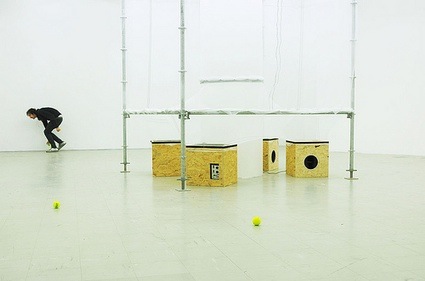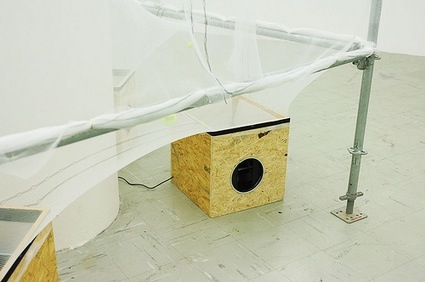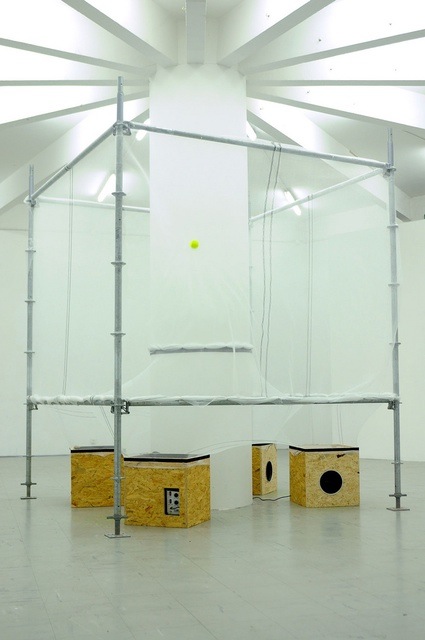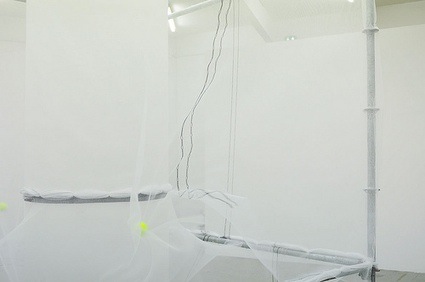
Back to Aix-en-Provence for the GAMERZ festival. One of the works i found most fascinating to watch during the opening of one of the shows at the Fondation Vasarely was Paul Destieu‘s NADAL.
The installation borrows the name of the famous tennis champion, except that the sole role humans can play here is the most humble one: picking up lost balls. That’s if they dare to approach NADAL.
In NADAL’s degenerated form of tennis, several tennis ball machines propel balls on a meticulously calibrated trajectory that animate and play with the architectural space.
NADAL during a previous exhibition, in KIBLA, Maribor, Slovenia
The description of the installation was so succinct (something the French have not quite used me to!) that i decided to ask Paul Destieu a couple of questions about his curious machine:
The text on your website says that “The machine propels balls on a meticulously calibrated trajectory in order to generate a space emulation.” Can you tell us how you calibrated this trajectory? How was this calibration designed (technically) and why you designed it that way? To what purpose?
The project NADAL is an attempt to develop a game of bouncing balls and trajectories which runs in loop through the space. This circuit is activated by 4 tennis ball machines, each of them functions as checkpoints for the balls and they are calibrated in order to shape a relay form. The calibration is also developed with a site specific concern, in order to produce some bouncing interactions and a vigorous circulation in the environment where it is integrated.
At the Fondation Vasarely, the circuit is based on a symmetrical pattern of trajectories and it produces a circulation all around the central column of the hexagonal shaped room. I use the several grounds/sides of the space – walls, ceiling and ground – to enable a physical activation and a confrontation with the architectural scale.
The process of calibration for this project usually looks like some kind of 3D pool game: a mashup of calculation, geometrical intuitions and empirical compromises.
 Are the tennis ball machines interacting with each other or does each one follow its own rules?
Are the tennis ball machines interacting with each other or does each one follow its own rules?
The installation is launched by a motion censor which aims at synchronizing the global circuit, then the machine is set in order to feed the other one. If the interaction between the 4 machines is reduced to a minimal level, the purview takes its revenge on the dialogue that is engaged with the architecture. The interaction is perhaps shifted to the relation between the machines and their environment which equally rules the system and articulates it.
 When i saw the installation at the Fondation Vasarely i was particularly seduced by the sound. Then i was irritated, because the machine seemed to be happy to play on its own and no human was necessary, except to collect balls. I can’t decide whether you made the project because you love or hate tennis. Or is project NADAL a twisted take on the ever so popular “interactivity”?
When i saw the installation at the Fondation Vasarely i was particularly seduced by the sound. Then i was irritated, because the machine seemed to be happy to play on its own and no human was necessary, except to collect balls. I can’t decide whether you made the project because you love or hate tennis. Or is project NADAL a twisted take on the ever so popular “interactivity”?
The sound definitely plays an important role in this installation. The motors produces a latent mechanical background noise punctuated by the impacts of balls. Depending on the speed of the balls, the bounces are more or less violent and echo through the space as an answer to the architecture.
The machines which are used in this installation are rudimentary kinds of tennis robots. Like every machines, their are designed with a margin of error and they love expressing it.
A lot of physical elements (pressure of balls, density and imperfection of the walls, erosion of the machines) interfere with the geometrical plan which should rule the piece in a perfect conceptual environment.
The project NADAL is an attempt to get close to a geometrical fantasy. By facing the limits of performance and failure, by challenging borders between a champion and a machine, it can be seen as one of the constant love & hate story (interaction) which shapes our relationship with technologies.
 What are the minimum architectural space characteristics that the work requires? Is the effect of the installation completely different whether the room is larger, smaller, higher, etc?
What are the minimum architectural space characteristics that the work requires? Is the effect of the installation completely different whether the room is larger, smaller, higher, etc?
The installation NADAL can be adapted to many configurations, but the most minimal one I could think of, still requires a basket for the machine to enable the reception of the balls and of course electricity. The first version of the project was supplied by a single machine that was looping on its own. I recently presented in Maribor, Slovenia, a version based on two arches facing each other, leading the visitor’s flow on an orthogonal circuit around the looping relay.
I first imagined NADAL in an outdoor urban context, but it seems that the indoor configuration produced an efficient contrast out of the strength of the ejected balls compressed in a closed environment. That was my very late discovery of Squash, it felt like you could get a raw and physical taste of surrounding walls which could be a solid starting point of work.
The Office, Season 6, Parkour (clip suggested by Paul)
The presentation text on the festival website refers to urban sport. Such as parkour and roof soccer (omg, is this for real?) Can you explain us why this reference to urban sport?
In both of these practices, it seems that there is an hijacking process of the close environment. Walls and buildings loose their natures of physical borders to be turned into playgrounds. It was also my approach in this work, I tried to take advantage
of the space through a series of bouncing which will hopefully lead to a next checkpoint.
Merci Paul!
Project NADAL is up at the Fondation Vasarely in Aix-en-Provence as part of the GAMERZ festival running until 19th December, 2010.
Image credit: Luce Moreau, courtesy Sylvain, Gamerz festival.
